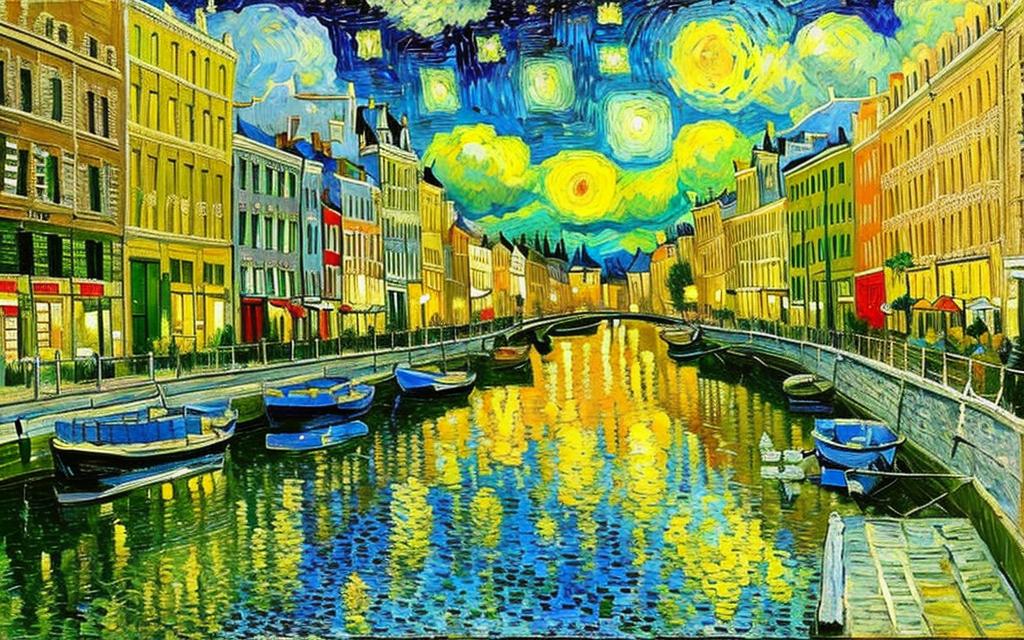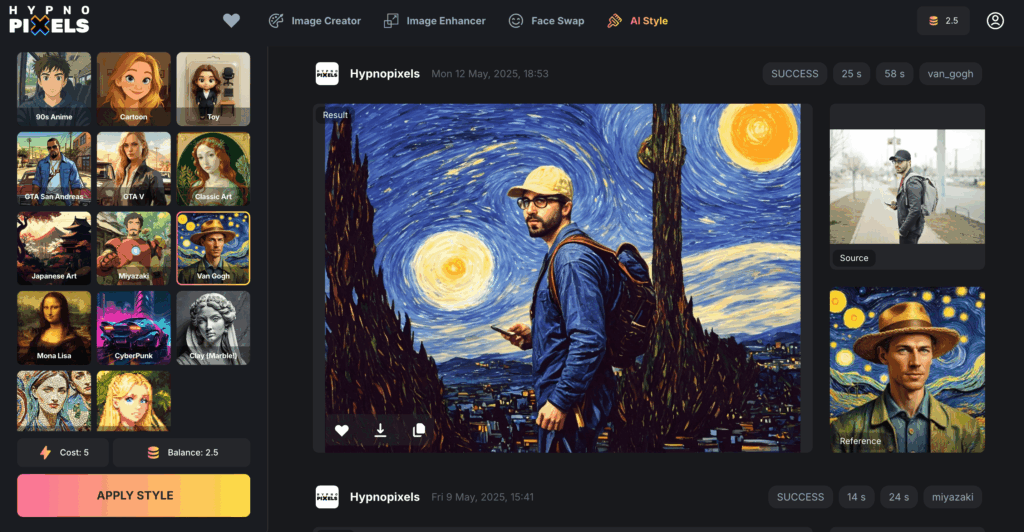How to generate Vincent Van Gogh art style
Did you know the Vincent van Gogh art style we admire today emerged from creating approximately one artwork every 36 hours? That’s right – this legendary artist produced over 2,000 drawings and paintings in just over a decade, showcasing his extraordinary dedication and passion.
Interestingly, Vincent van Gogh is considered the father of Expressionism, blending techniques from Impressionism and Pointillism to create his revolutionary approach. His distinctive van Gogh painting style features thick, swirling brushstrokes applied through the impasto technique, often using paint straight from the tube. Furthermore, his work evolved from dark, neutral tones to vibrant palettes that conveyed complex human emotions – a transformation that influenced major art movements like Fauvism.
Today, we can harness the power of AI to recreate this iconic van Gogh art style without spending years mastering his techniques. Whether you’re an art enthusiast or digital creator, generating AI art in the van Gogh style has never been more accessible. In this guide, we’ll walk you through the process of creating stunning AI van Gogh artwork and introduce you to Hypnopixels.com – the best application for achieving authentic van Gogh-inspired digital masterpieces.
Understanding Van Gogh’s Art Style
To truly generate AI art in the Vincent van Gogh art style, we need to understand what makes his work so recognizable. Van Gogh developed his distinctive style during the final decade of his life, creating approximately 860 oil paintings that showcase his unique approach to art.
Preparing to Generate AI Art in Van Gogh Style
Before diving into AI tools for creating Vincent van Gogh style artwork, proper preparation is essential to achieve authentic results. The AI technology that transforms ordinary images into Van Gogh-inspired masterpieces works best when you lay the right groundwork first.
Choose a subject that fits Van Gogh’s themes
The first step toward creating convincing AI van Gogh art is selecting a subject that aligns with his preferred themes. Van Gogh’s oeuvre encompasses landscapes, portraits, still life, and interior scenes—each showcasing his unique approach to color, texture, and composition. This diversity provides a rich foundation for AI models to learn from.
To achieve the most authentic results:
- Landscapes: Consider countryside scenes, wheat fields, starry skies, or cypress trees
- Portraits: Self-portraits or expressive faces with emotional depth
- Still life: Simple objects like chairs, flowers (especially sunflowers), or fruit

As the AI analyzes your chosen subject, it will apply Van Gogh’s distinctive style more effectively if the subject matter already resonates with his thematic preferences. Importantly, the storytelling qualities behind your chosen subject matter significantly impact the final result, as Van Gogh’s expressive paintings are examples of true creativity.
Select a reference image or sketch
Next, I need to prepare a base image or sketch that the AI can transform. According to the process outlined by various AI art generators, I have two primary options:
Starting from scratch: I can use text-to-image features by typing detailed descriptions of the scene I want to create. For instance, if I’m imagining a wheat field with crows, I would describe the elements, lighting, and mood in detail.
Using existing images: Alternatively, I can upload a photo or sketch as a reference. The AI will then reinterpret it in Vincent’s distinctive style. This approach works particularly well for landscapes, as demonstrated by projects that transform photos of cityscapes, mountains, and fields into Van Gogh style images.
For optimal results, my reference image should have clear compositional elements and defined shapes. Neural style transfer works by analyzing three components: a content image, a style reference image, and the input image I want to style. The quality of each affects the final output.
Understand lighting and mood for consistency
Finally, understanding lighting and mood is crucial for creating AI art that truly captures the van gogh painting style. Van Gogh’s works are known for conveying deep emotions through vibrant colors and dynamic brushstrokes.
Before generating my AI artwork, I should consider:
Emotional tone: What feeling do I want to convey? Van Gogh’s emotional intensity is reflected in his art, making this consideration vital for authentic results.
Color palette: Should I emphasize Van Gogh’s signature yellows and blues, or the darker tones from his earlier work? The choice affects the overall mood.
Lighting direction: Van Gogh often used dramatic lighting to enhance emotional impact. Deciding on lighting direction beforehand helps the AI algorithm apply appropriate shadows and highlights.
Through careful attention to these preparation steps, I can guide the AI to generate more authentic Vincent van Gogh style art. The preparation phase essentially involves constructing an effective prompt that specifies style, scene, and stylistic details like “thick brushstrokes” or “vivid colors”. This thoughtful preparation consequently leads to more satisfying results when I move to the actual generation process.
Best App to Generate Van Gogh Style AI Art
After exploring various AI art generators, Hypnopixels.com emerges as the premier choice for creating Vincent van Gogh style artwork. With its specialized features and user-friendly interface, this platform makes recreating the master’s techniques accessible to artists and enthusiasts alike.
Why Hypnopixels.com stands out

Hypnopixels has established itself as the “#1 Choice in United States” for AI image styling. Unlike general-purpose AI generators, Hypnopixels specifically excels at artistic style transfer, making it ideal for capturing the distinct vincent van gogh painting style. The platform allows me to instantly transform any image into various artistic styles, with Van Gogh being one of its specialized offerings.
What sets Hypnopixels apart is its precision in replicating the authentic characteristics of Van Gogh’s work. The platform’s AI algorithms accurately reproduce the swirling brushstrokes, bold color contrasts, and emotional intensity that define the van gogh art style. Moreover, its processing speed delivers transformed images in seconds, perfect for experimenting with different approaches to achieve the most authentic results.
Features that support Van Gogh-style generation
Hypnopixels offers several technical capabilities that make it particularly effective for generating vincent van gogh style art:
- High-Quality Style Transfer – The AI precisely replicates colors, textures, and brushstrokes from Van Gogh’s paintings, ensuring authentic transformation
- Instant Results – Upload your image, select the Van Gogh style, and receive your transformed artwork within seconds
- Diverse Style Library – Beyond Van Gogh, the platform offers various other artistic styles including Classic Art and Japanese Art
Remarkably, Hypnopixels maintains high resolution throughout the transformation process, supporting images up to 10MB with a maximum resolution of 6000×6000 pixels. This ensures that the intricate details characteristic of van gogh painting style are preserved in the final output.
How to use Hypnopixels for best results
Utilizing Hypnopixels for creating Van Gogh-inspired artwork is straightforward. First, I upload my base image in JPEG, PNG, or GIF format. For optimal results, high-quality images work best. Next, I select the Van Gogh style from the available options. The platform then processes my image, applying the distinctive brushwork and color palette characteristic of Vincent van Gogh.
Naturally, experimentation yields the best outcomes. By adjusting the base image and trying different photographs, I can discover which subjects translate most effectively into the van gogh style. After processing, the platform allows me to download my transformed image immediately.
Although no technical expertise is required, understanding Van Gogh’s artistic elements helps me select appropriate subjects and base images that will transform most convincingly into his style. Additionally, privacy-conscious users will appreciate that Hypnopixels processes images securely and doesn’t store them longer than necessary.
Conclusion
The journey through Vincent van Gogh’s distinctive artistic world reveals how AI technology now brings his revolutionary style within reach for everyone. Throughout this guide, we’ve explored the core elements that make his work instantly recognizable—from the thick, directional brushstrokes and vibrant color contrasts to the emotional distortion of forms. These elements, once mastered only through years of dedicated practice, can now be applied to our own images through sophisticated AI tools.
After all, what makes Van Gogh’s style truly remarkable isn’t just his technical approach but the emotional intensity conveyed through each canvas. AI generators like Hypnopixels.com effectively capture this essence, transforming ordinary photos into works that pulse with Van Gogh’s characteristic energy. The platform stands out specifically because of its precision in replicating authentic brushwork patterns and color relationships that defined the master’s hand.
Though the technology does most of the heavy lifting, your understanding of Van Gogh’s techniques significantly enhances the final results. By selecting appropriate subjects, paying attention to color relationships, and adding textural elements, you create AI artwork that genuinely honors Van Gogh’s legacy rather than merely imitating it.
The accessibility of these tools certainly democratizes artistic expression in unprecedented ways. Previously, creating convincing Van Gogh-style art required extensive training and practice. Now, anyone with a creative vision can experiment with this iconic style, regardless of their technical artistic abilities.
Why not start your own artistic journey today by uploading an image to Hypnopixels.com and watching it transform before your eyes? The satisfaction of seeing your personal photos reimagined through Van Gogh’s expressive lens might surprise you.
Undoubtedly, Van Gogh himself—who struggled for recognition during his lifetime—would find it remarkable that his unique artistic vision continues to inspire and evolve through 21st-century technology. The marriage of classical artistic techniques with cutting-edge AI represents not just technological advancement but a new chapter in our ongoing conversation with art history.
